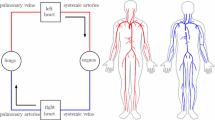Abstract
A mathematical model of the infant pulmonary vascular system was developed by altering an adult model to fit the hemodynamic properties of an infant pulmonary vascular bed. The model was designed for infants between the ages of 1 and 2 years with both normal and high mean pulmonary artery pressures (PAPs). The resulting infant model was evaluated on the basis of the computed parameters of cumulative length, volume and resistance of the pulmonary vascular bed, as well as on the basis of comparisons of the model spectra with actual computed spectra for ventricular septal defect patients who were of comparable age, had comparable mean PAPs and were not diagnosed as having pulmonary vascular disease. It was observed that the first minimum and first maximum in the modulus of the input impedance spectrum of the infant model for both normal and high mean PAPs occurred at a higher frequency than in the adult model. These observations led to the conclusion that there is a natural, age-related shift in the input impedance spectrum of infants which is not necessarily indicative of pulmonary impairment.
Similar content being viewed by others
References
Aziz, K.U., M.A. Nanton, L. Kidd, C.A.F. Moes and R.D. Rowe. Variation in the size and distensibility of the pulmonary arteries in d-transposition of the great arteries.Am. J. Cardiol. 38:452–457, 1976.
Bargainer, J.D. Pulse wave velocity in the main pulmonary artery of the dog.Circ. Res. 20:630–637, 1967.
Bergel, D.H. and W.R. Milnor. Pulmonary vascular impedance in the dog.Circ. Res. 16:401–415, 1965.
de la Cruz, M.V., G. Anselmi, A. Romero and G. Monroy. A qualitative and quantitative study of the ventricles and great vessels of normal children.Am. Heart J. 60:675–690, 1960.
Gonza, E.R., A.E. Marble, A. Shaw and J.G. Holland. Age related changes in the mechanics of the aorta and pulmonary artery of man.J. Appl. Physiol. 36:407–411, 1974.
Heath, D., J.W. Dushane, H. Woode and J.E. Edwards. The structure of the pulmonary trunk at different ages and in cases of pulmonary hypertension and pulmonary stenosis.J. Pathol. Bacteriol. 77:443–456, 1959.
Hislop, A.A. and L. Reid. Pulmonary arterial development during childhood: branching pattern and structure.Thorax 28:129–135, 1973.
Hoffman, J.I.E., A.M. Rudolph and M.A. Heymann. Pulmonary vascular disease with congenital heart lesions: pathologic features and causes.Circulation 64:873–877, 1981.
Hwang, N.H.C. and N.A. Normann, eds.Cardiovascular Flow Dynamics and Measurements Baltimore: University Park Press, 1977, p. 108.
Jarmakani, J.M.M., T.P. Graham Jr., B. Benson Jr., R.V. Canent Jr. and J.C. Greenfield Jr. In vivo pressure-radius relationships of the pulmonary artery in children with congential heart disease.Circulation 43:585–592, 1971.
Lefevre, J. Simple model representation of the pulmonary input impedance by an elastic tube matched with a lumped load.Inserm 78:73–86, 1978.
Lucas, C.L. Fluid mechanics of the pulmonary circulation.CRC Crit. Rev. Biomed. Eng. 10:317–393, 1984.
Lucas, C.L., B.R. Wilcox and N.A. Coulter. Pulmonary vascular response to atrial septal defect closure in children.J. Surg. Res. 18:571–586, 1975.
Milnor, W.R.Hemodynamics. Baltimore: Williams and Wilkins, 1982.
Milnor, W.R., C.R. Conti, K.B. Lewis and M.F. O'Rourke. Pulmonary arterial pulse wave velocity and impedance in man.Circ. Res. 25:637–649, 1969.
Newman, D.L. and S.E. Greenwald. Validity of the Moens-Korteweg equation. In:The Arterial System: Dynamics, Control Theory and Regulation, edited by R.D. Bauer and R. Busse. New York: Springer-Verlag, 1978, pp. 109–115.
Pollack, G.H., R.V. Reddy and A. Noordergraaf. Input impedance, wave travel, and reflections in the human pulmonary arterial tree: studies using an electrical analog.IEEE Trans. Biomed. Eng. BME-15:151–164, 1968.
Radke, N.F., C.L. Lucas and B.R. Wilcox. Detection of pulmonary vascular disease in infants using input impedance spectra.Circulation 70:458, 1984.
Wiener, F., E. Morkin, R. Skalak and A.P. Fishman. Wave propagation in the pulmonary circulation.Circ. Res. 19:834–850, 1966.
Wilcox, B.R. and C.L. Lucas. Pulmonary input impedance in children with left-right shunt.J. Surg. Res. 29:40–49, 1980.
Author information
Authors and Affiliations
Rights and permissions
About this article
Cite this article
Radke, N.F., Lucas, C.L., Wilcox, B.R. et al. Infant pulmonary vascular model based on the pulmonary input impedance spectrum. Ann Biomed Eng 13, 531–550 (1985). https://doi.org/10.1007/BF02584256
Issue Date:
DOI: https://doi.org/10.1007/BF02584256




